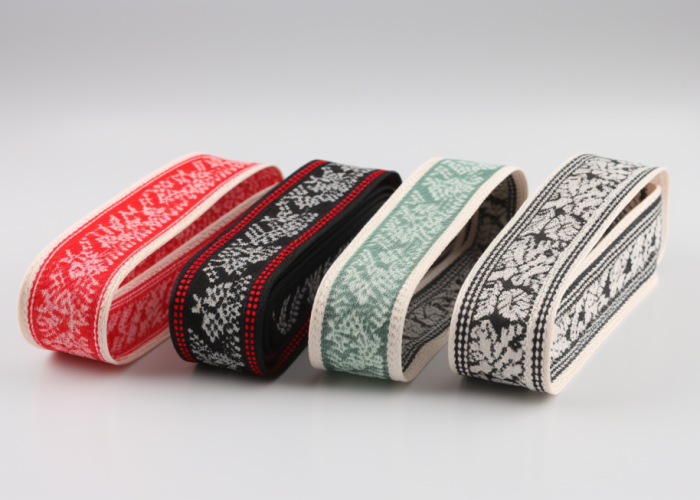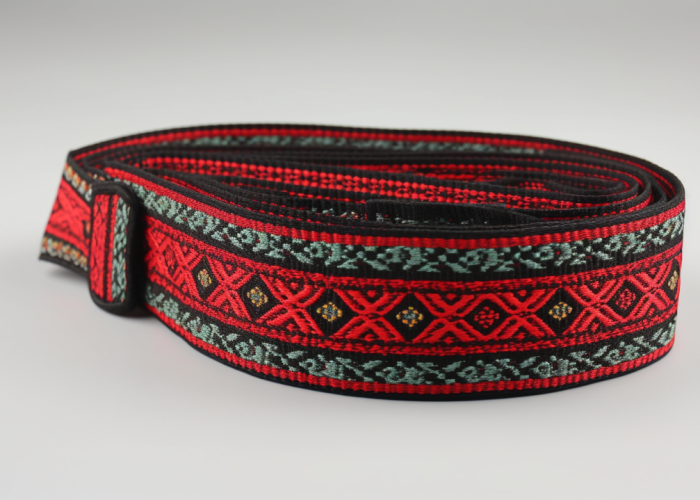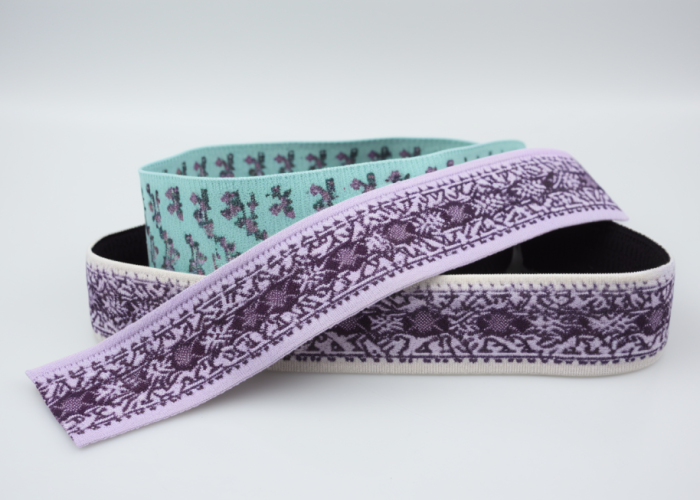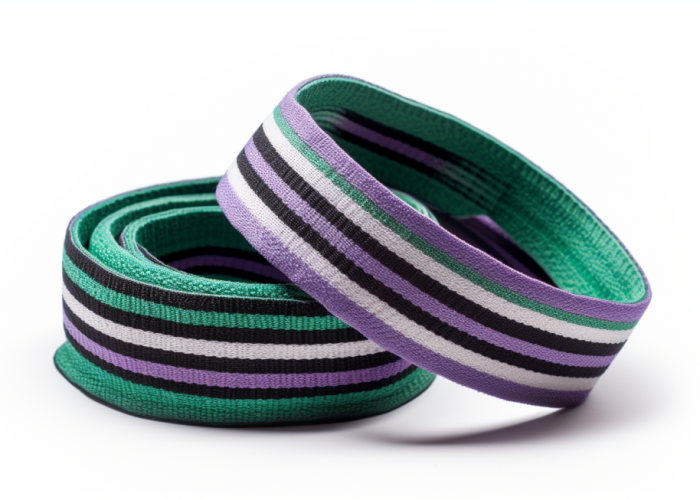Selecting the right jacquard webbing density is crucial for achieving precise pattern reproduction in product designs. Our 15+ years manufacturing custom jacquard webbing has shown how density directly impacts pattern definition across industries, where engineers often struggle balancing visual detail against texture requirements.
High-density jacquard webbing is superior for detailed patterns because it delivers 30-40% finer detail resolution than standard density alternatives. The increased thread count (150+ threads per inch) creates smoother, tighter patterns with enhanced optical impact and precise edge definition, making it ideal for intricate logos, geometric designs, micropatterns, and text elements where visual clarity is essential.
We’ll explore ideal pattern types for high-density jacquard webbing, compare pattern clarity across densities, and help you choose based on technical needs and visual goals.


Webbing manufacturing expert with 15+ years of experience helping product developers build high-performance straps for industrial, medical, and outdoor use.
Weave density affects pattern definition in jacquard webbing by directly controlling the level of detail and texture clarity. High-density weaves create smoother, tighter patterns with finer detail resolution due to increased thread count, while requiring specialized manufacturing equipment to achieve optimal pattern definition and surface consistency.
High-density jacquard webbing achieves superior pattern definition through precise thread placement and minimal spacing between individual threads. This technical advantage comes from manufacturing processes that maintain consistent tension across all warp and weft elements. Our testing shows that increasing thread density by 25% can improve pattern edge definition by up to 40%, particularly in intricate designs with multiple color transitions.
The specialized equipment required for high-density jacquard production includes advanced electronic jacquard heads capable of controlling individual thread movements with greater precision. These systems allow for the creation of complex patterns without sacrificing structural integrity or production efficiency. The increased thread count also provides a more stable foundation for pattern creation, reducing distortion during the weaving process.
High-density jacquard webbing is visually characterized by fine, intricate patterns with sharper details and precise edges compared to lower-density alternatives. The enhanced pattern precision creates superior optical impact with cleaner line definition and improved color transitions, making it ideal for applications requiring visual clarity and fine detail reproduction.
The superior detail precision in high-density jacquard comes from the tight arrangement of threads that eliminates gaps typically seen in lower-density weaves. This construction method allows for smoother curves in designs and minimizes the “stepped” appearance common in diagonal or curved elements of patterns woven at lower densities. When examined closely, high-density webbing shows consistent pattern integrity across the entire width with minimal distortion at edges.
Pattern appearance in high-density jacquard benefits from enhanced color definition and more precise transitions between different colored areas. The tighter weave structure allows for more exact color placement, creating cleaner boundaries between pattern elements. This characteristic is particularly valuable in brand logos or text reproduction where crisp, easily readable elements are essential for proper brand representation.

Pattern types that show best in high-density jacquard webbing include geometric designs, logos, text elements, micropatterns, and 3D embossed patterns. These design categories benefit from high-density construction because their visual impact depends on precise edge definition, consistent line thickness, and accurate reproduction of small details.
Geometric patterns achieve exceptional clarity in high-density jacquard due to the precise angle maintenance and consistent line thickness possible with tighter thread arrangements. Complex shapes with multiple internal elements retain their intended proportions throughout the design. Zig-zag patterns particularly benefit from high-density construction, as the sharp angles and directional changes maintain their definition without blurring at transition points.
Logo and text elements require high-density weaving to maintain legibility and brand recognition. Our testing shows that text smaller than 5mm remains readable in high-density webbing while becoming indistinct at lower densities. This makes high-density jacquard essential for applications where brand identifiers must be clearly visible on relatively narrow webbing widths.
Micropatterns and 3D embossed designs show remarkable improvement in high-density constructions. Small repeating elements that might blur together in standard weaves remain distinct and visually separate in high-density alternatives. For 3D patterns, the additional thread count provides greater structural support for raised elements, allowing for more pronounced dimensional effects while maintaining pattern integrity.
Light reflection enhances high-density jacquard patterns by creating more defined contrast between pattern elements due to the smoother surface texture. The consistent thread positioning in high-density weaves creates more uniform light reflection characteristics, improving pattern visibility under varying lighting conditions and enhancing the perceived quality of the finished product.
The significant role light plays in pattern visibility becomes apparent when comparing identical designs in different density constructions. High-density weaves create more consistent surface planes that reflect light evenly across pattern areas, enhancing the visual separation between different elements. This quality is particularly valuable in indoor applications where controlled lighting can maximize pattern visibility.
When light strikes high-density jacquard webbing, the reduced surface texture minimizes scattered reflection that can diminish pattern clarity. Instead, the smoother surface creates more predictable reflection angles that enhance pattern definition. This characteristic makes high-density jacquard particularly valuable for applications where webbing will be viewed under varying light conditions or where aesthetic appearance is a primary consideration.

Applications that benefit most from high-density jacquard webbing include products requiring complex decorative patterns, precise brand representation, or visual communication elements. Luggage and bag accessories, premium apparel components, automotive interior elements, and high-end consumer products achieve superior aesthetic quality and brand recognition through the enhanced pattern definition high-density jacquard provides.
High-density jacquard excels in applications where the webbing serves both functional and brand identification purposes. The ability to reproduce complex corporate logos with accurate color placement and precise shape definition makes high-density construction essential for products where brand identity must be clearly communicated through relatively small webbing components.
Technical applications requiring visual indicators or coded information also benefit from high-density construction. The improved text legibility and symbol definition enable more effective communication of important information in applications where misinterpretation could impact safety or functionality. This makes high-density jacquard valuable in specialized industrial applications beyond purely decorative uses.
High-density jacquard compares to low-density for pattern visibility by offering superior detail definition and edge precision, while low-density provides enhanced tactile feedback and dimensional appearance. This fundamental difference means high-density excels in applications requiring visual clarity, while low-density performs better when tactile engagement or textural contrast is the primary objective.
Low-density jacquard creates more prominently raised patterns with greater texture variation across the webbing surface. This construction method produces more noticeable pattern elements that can be identified through touch even without visual inspection. The increased dimensional quality makes low-density jacquard appropriate for applications where tactile identification or textural contrast is desired.
The trade-off between the two density options becomes apparent when examining pattern definition. High-density construction achieves significantly cleaner transitions between pattern elements and more accurate reproduction of intended designs. Low-density options, while visually bolder, often experience some distortion or simplification of complex elements due to the limitations of the looser thread structure.

Different weave types respond uniquely to high-density processing with satin/sateen developing exceptional smoothness and subtle luster, twill creating refined diagonal patterns with enhanced flow, and basic weaves producing more consistent surfaces with improved pattern definition.
Satin/sateen weaves maximize high-density benefits through enhanced smoothness and controlled light reflection, creating premium-looking webbing ideal for applications where aesthetic quality is essential. The smooth surface provides an optimal foundation for intricate pattern details that might be lost in more textured constructions.
Twill weave patterns develop smoother diagonal lines with consistent spacing in high-density processing. The characteristic diagonal structure becomes more refined and continuous, enhancing pattern flow while maintaining integrity even under tension or flexing. This makes high-density twill particularly effective for applications requiring both visual quality and functional performance.
Basic weave structures achieve consistent surface textures and substantially improved pattern definition with high-density processing. The precise thread control allows for accurate pattern placement even in simple over/under constructions, eliminating pattern limitations typically associated with standard-density basic weaves while retaining their inherent durability advantages.
High-density jacquard webbing delivers superior pattern definition through increased thread count and precision manufacturing. Its exceptional detail reproduction makes it ideal for intricate designs, logos, and micropatterns. For product developers requiring visual clarity and brand recognition, high-density jacquard provides the optimal balance of aesthetic quality and functional performance.
The minimum thread count for high-density jacquard webbing is typically 150+ threads per inch. This density threshold enables the fine detail reproduction and pattern precision that distinguishes high-density constructions from standard alternatives, while maintaining structural integrity for practical applications.
Density impacts jacquard webbing durability through thread structure and integration. High-density constructions offer greater resistance to abrasion and surface wear due to tighter thread arrangement, while low-density options sometimes provide better flexibility under repeated bending stress. Application requirements should determine which durability factor takes priority.
Yes, high-density jacquard webbing costs approximately 25-35% more than low-density alternatives. The price difference reflects additional material requirements, specialized equipment usage, and more complex manufacturing processes necessary to achieve superior pattern definition and visual clarity.
Webbing width directly impacts pattern visibility in high-density jacquard by determining the available space for detail reproduction. Wider webbing (2+ inches) accommodates more complex patterns while maintaining definition, while narrower webbing benefits from high-density construction to preserve essential pattern elements in limited space.
Yes, geometric patterns can be produced in both density options, but with different results. High-density jacquard creates precise, sharply defined geometric patterns with accurate angles and consistent line weights, while low-density produces bolder but less defined geometrics with enhanced textural quality.
High-density jacquard webbing typically requires less frequent cleaning due to its tighter construction that prevents dirt accumulation within the weave structure. The smoother surface also makes cleaning more effective when needed, extending the visual lifespan of pattern elements compared to textured low-density alternatives.